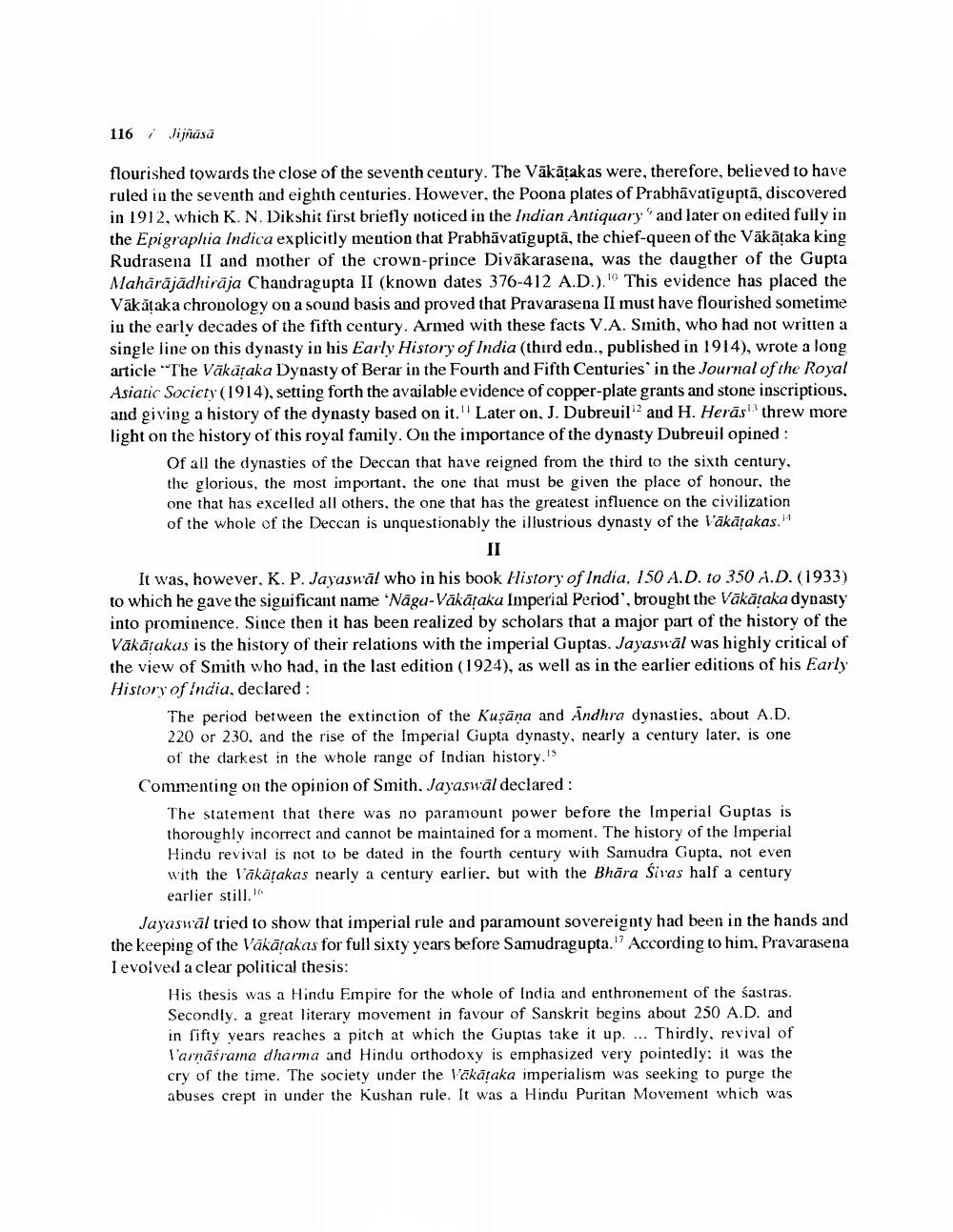________________
116
Jijñāsa
flourished towards the close of the seventh century. The Vākätakas were, therefore, believed to have ruled in the seventh and eighth centuries. However, the Poona plates of Prabhāvatiguptā, discovered in 1912, which K. N. Dikshit first briefly noticed in the Indian Antiquary and later on edited fully in the Epigraphia Indica explicitly mention that Prabhāvatīguptā, the chief-queen of the Vākātaka king Rudrasena II and mother of the crown-prince Divākarasena, was the daugther of the Gupta Mahārājādhiraja Chandragupta II (known dates 376-412 A.D.). This evidence has placed the Vākātaka chronology on a sound basis and proved that Pravarasena II must have flourished sometime in the early decades of the fifth century. Armed with these facts V.A. Smith, who had not written a single line on this dynasty in his Early History of India (third edn., published in 1914), wrote a long article "The Vākāraka Dynasty of Berar in the Fourth and Fifth Centuries in the Journal of the Royal Asiatic Society (1914), setting forth the available evidence of copper-plate grants and stone inscriptions, and giving a history of the dynasty based on it." Later on, J. Dubreuil- and H. Heräs threw more light on the history of this royal family. On the importance of the dynasty Dubreuil opined:
Of all the dynasties of the Deccan that have reigned from the third to the sixth century, the glorious, the most important, the one that must be given the place of honour, the one that has excelled all others, the one that has the greatest influence on the civilization of the whole of the Deccan is unquestionably the illustrious dynasty of the Vākātakas.
II It was, however, K. P. Jayaswäl who in his book History of India, 150 A.D. to 350 A.D. (1933) to which he gave the significant name "Nāga-Vākāfaka Imperial Period', brought the Vākātaka dynasty into prominence. Since then it has been realized by scholars that a major part of the history of the Vākātakas is the history of their relations with the imperial Guptas. Jayaswäl was highly critical of the view of Smith who had, in the last edition (1924), as well as in the earlier editions of his Early History of India, declared :
The period between the extinction of the Kuşāna and Andhra dynasties, about A.D. 220 or 230, and the rise of the Imperial Gupta dynasty, nearly a century later, is one
of the darkest in the whole range of Indian history." Commenting on the opinion of Smith. Jayaswal declared :
The statement that there was no paramount power before the Imperial Guptas is thoroughly incorrect and cannot be maintained for a moment. The history of the Imperial Hindu revival is not to be dated in the fourth century with Sarnudra Gupta, not even with the Vākärakas nearly a century earlier, but with the Bhāra Sivas half a century
earlier still." Jayasuāl tried to show that imperial rule and paramount sovereignty had been in the hands and the keeping of the Väkātakas for full sixty years before Samudragupta." According to him, Pravarasena I evolved a clear political thesis:
His thesis was a Hindu Empire for the whole of India and enthronement of the sastras. Secondly, a great literary movement in favour of Sanskrit begins about 250 A.D. and in fifty years reaches a pitch at which the Guptas take it up. ... Thirdly, revival of Warnäsrama dharma and Hindu orthodoxy is emphasized very pointedly: it was the cry of the time. The society under the Vākātaka imperialism was seeking to purge the abuses crept in under the kushan rule. It was a Hindu Puritan Movement which was




